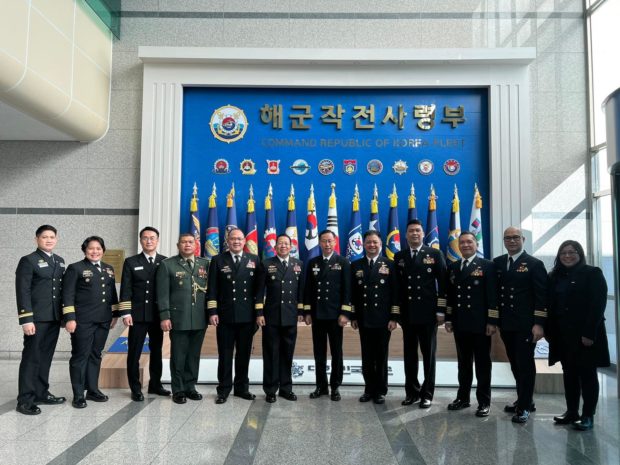PH, Korea, US end defense talks

The Philippine Navy and the Republic of Korea Navy held the second navy-to-navy staff talks on Dec. 1, 2022 in Busan, South Korea. (Photo from the Philippine Naval Public Affairs Office)
MANILA, Philippines — The Philippines and South Korea held wide-ranging naval cooperation talks, including submarine training programs, as Manila also ended planning sessions with Washington on their biggest army-level exercise next year, involving some 3,000 troops.
The Philippine and US armies wrapped up their planning conference in Manila last week for next year’s iteration of “Salaknib” (shield in the Ilocano language), an annual exercise to strengthen the readiness and interoperability of both armies.
At the same time, the Philippine and South Korean navies also held their second staff-to-staff talks in Busan, South Korea, from Nov. 28 to Dec. 2, the Korean Embassy in Manila said.
The talks also touched on education and other trainings, people-to-people exchanges, logistics cooperation, combined exercises and ship visits, the Philippine Navy said in a separate statement.
The Philippine delegation, led by Commodore Jose Ma Ambrosio Ezpeleta, also visited the Korean submarine command at Jinhae Naval Base and a shipyard in Ulsan where naval vessels to be acquired by the Philippines are being built.
Submarine acquisition plan
The Philippine Navy has pending orders for two corvettes and six offshore patrol vessels, costing a total of P58 billion, from South Korean shipbuilder Hyundai Heavy Industries.
Daewoo Shipbuilding & Marine Engineering has also offered to the Philippines its Chang Bogo-class diesel-electric submarines, but the Navy is also considering a French offer for Scorpene-class diesel-electric submarines.
The military’s modernization program calls for the acquisition of two diesel-electric attack submarines worth P70 billion.
But dozens of projects under the current plan worth P300 billion remain unfunded. The diversion of government funds due to the pandemic has also been attributed to the delays in the modernization program.
Manila and Seoul have been further expanding their defense partnership through the years after it was cemented by the Philippine deployment of troops during the Korean War in the 1950s.
In October, the Republic of Korea Marine Corps sent 120 troops for the first time to the Kamandag exercise in Luzon, which involved 3,300 personnel from the Philippines, United States, Japan, and South Korea.
Acting Defense Secretary Jose Faustino Jr. and Korea’s Defense Minister Lee Jong-sup recently agreed on the need to strengthen strategic cooperation during bilateral talks on the sidelines of the Association of Southeast Asian Nations Defense Ministers’ Meeting-Plus in Cambodia, according to Korean news agency Yonhap.
Salaknib 2023 readied
While Navy officials held talks in Busan, the Philippine Army also concluded planning sessions for the Salaknib exercise, which will be conducted in two phases—from mid-March to early April and June—in various areas in Luzon.
The participating troops will come from the Army’s 5th Infantry Division, 7th Infantry Division and 1st Brigade Combat Team; and the United States’ Army Pacific’s 25th Infantry Division, the Army said.
The annual drill is a testament to the “long-standing bilateral relations” of the two allies, according to Army chief Lt. Gen. Romeo Brawner Jr.
The Philippines recently dispatched 103 troops to the US-led regional training with allies in Hawaii that involved 6,000 American troops, and over 350 soldiers from the Philippines, Thailand, and Indonesia, along with nine observer countries.
“Majority of the forces in the region are armies. Everybody is concerned about the security of their sovereign territory… We all need to be able to work together no matter what the crisis is… we’ve got to be able to work together,” Lt. Gen. James Jarrard, deputy commanding general of the US Army Pacific, said in October.














